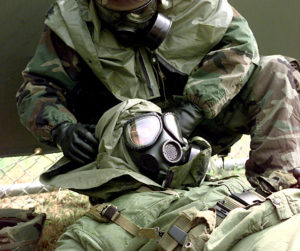By John A. Gilbert, Member, Scientists Working Group on Biological and Chemical Security
The recent attempted assassination of a former Russian intelligence officer and his daughter in Salisbury, England, is a dramatic demonstration that it is now time for the international community to deal seriously with the lingering threat of chemical weapons (CW). This attack was carried out with a nerve agent, a specific type of CW. Nerve agents interfere with the transmission of nerve impulses, leading to a characteristic set of serious to fatal symptoms. Victims exhibit loss of muscle control, “pinpointing” of their eyes, sweating, drooling, loss of control of bodily functions, and severe respiratory distress. Exposure to lethal amounts almost always results in an agonizing death if victims are not quickly given proper medical treatment. The UK government announced on March 12 that the nerve agent in this attack was part of a family of chemicals called “Novichok,” which was uniquely developed and secretly produced by the Soviet Union.
This CW attack is only the latest in a series that have taken place in recent years. In February 2017, Kim Jong Un’s half-brother was assassinated at a Malaysian airport by two women who used a binary form of the nerve agent VX. On March 25, 2017, a hospital in Latamneh, Syria, was attacked by “barrel bombs” filled with chlorine (a choking agent first used as a CW in World War I) resulting in the death of a doctor and a surgical patient. This was followed by a sarin attack against Latamneh on March 30, 2017. This incident caused more than 70 casualties, but no deaths, thanks to rapid medical response. On April 4, 2017, another sarin attack killed more than 80 civilians in the Syrian city of Khan Sheikhun. This April attack prompted a U.S. cruise missile strike on the Syrian airfield used by the attack aircraft. However, no further action was taken by the U.S. or others and the airfield is still in use.
The worst recent CW attack took place on August 21, 2013, when sarin was used against regime-opponent neighborhoods in two suburbs of Damascus, killing well over 1,000 civilians. Evidence showed that a unique type of ground-to-ground rocket designed by Iran and several Russian-designed rockets were used in the massacre. Following those attacks, international pressure led Syria to join the Chemical Weapons Convention (CWC), which is an international treaty banning the use, production, and stockpiling of CW, and requiring destruction of all CW stocks and their production facilities. To comply with the Treaty, Syria provided a data declaration, allowed international inspection of some of its facilities, and turned over its declared stockpile of about 1,300 metric tons of chemical weapons and precursors for destruction by third parties. Now it appears likely that either Syria reconstituted its CW production capability or failed to declare some residual stocks, which were then used against Latamneh and Khan Sheikhun in 2017. Additionally, dozens of cases of the use of chlorine against Syrian civilians have been documented, as recently as March 5, 2018 in Eastern Ghouta, where sarin attacks also occurred in 2013. Chlorine is a very common industrial chemical that is not specifically identified for verification under the CWC, and it is extremely hard to enforce controls on its production and storage. However, the use of chlorine against people is considered by the OPCW to be a prohibited activity.
The United Nations and the Organization for the Prohibition of Chemical Weapons (OPCW), which is the implementing body for the CWC, conducted UN-mandated investigations of sarin and chlorine use in Syria, providing hundreds of pages of evidence, but was blocked from attributing “guilt” by the limitations of its mandate. However, the evidence pointed in only one direction — that Syria, likely aided by Russia, conducted the 2013 and 2017 sarin attacks and multiple chlorine attacks.
Despite these well-publicized uses of CW, no effective action has been taken by the international community. As of yet, no action has been taken against North Korea for its extraterritorial use of VX. Russia vetoed a continuation of the joint UN-OPCW Syrian investigation and (other than a single cruise missile attack) no actions have been taken against Syria for use of sarin and chlorine against its own population or against Russia for its role in supporting Syria’s CW programs.
The recent assassination attempt in Salisbury has evoked strong statements and actions by the UK government. On March 14, the U.S. Ambassador to the United Nations issued a strong statement on this latest attack at a meeting of the UN Security Council, concurring with the UK identification of Russia as the perpetrator and supporting UK demands for accountability of this failure by Russia to meet its CWC obligations. It is now time for the OPCW and the UN Security Council to step up and have the fortitude to look at the facts, recognize who is to blame, and act to demonstrate that continuing violations of the CWC are unacceptable and have consequences. The world will be watching.

